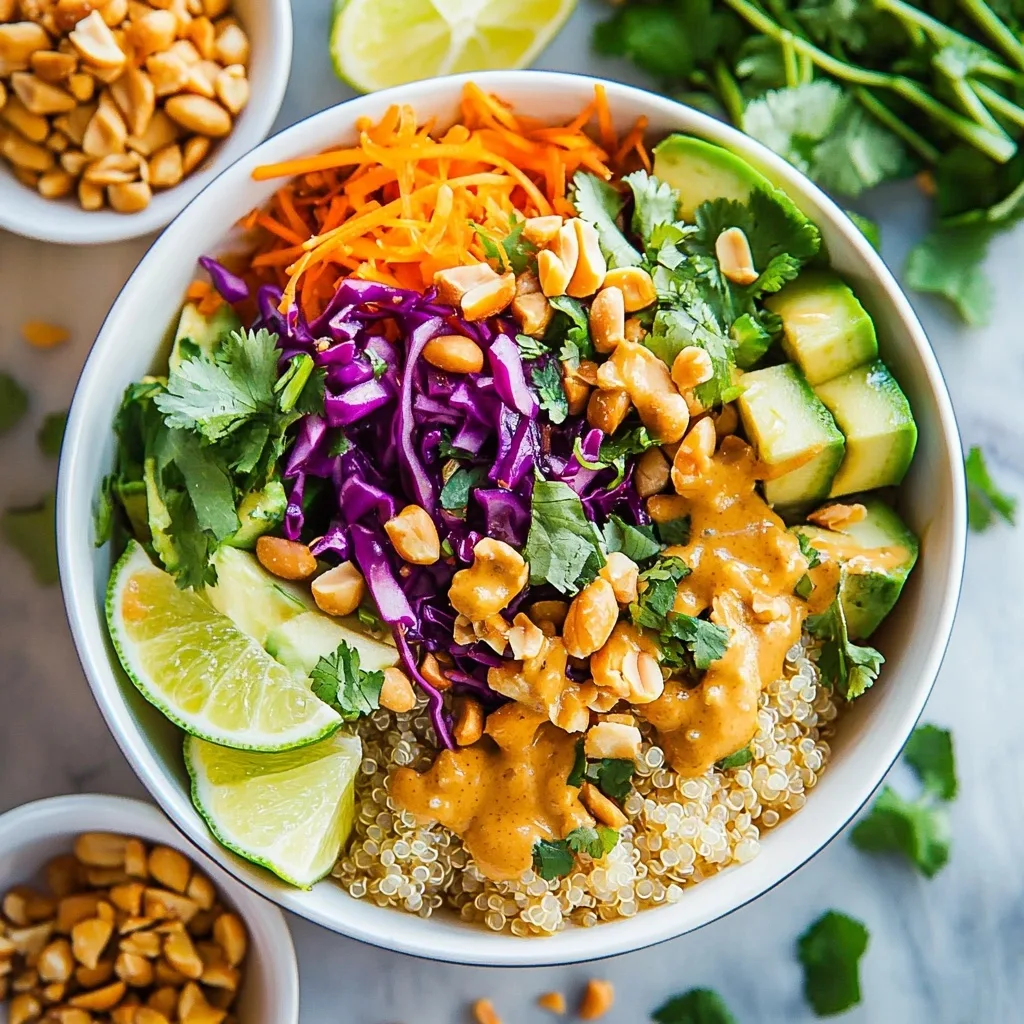Buddha bowls have taken the culinary world by storm, offering a perfect balance of nutrition, flavor, and visual appeal, all in a single dish. Among the many variations, the Thai Peanut Buddha Bowl stands out as a vibrant celebration of colors, textures, and tastes that will transform your mealtime into a sensory experience. This Thai-inspired creation combines nutrient-rich vegetables, protein-packed edamame, satisfying quinoa, and a luscious peanut sauce that ties everything together with remarkable harmony.
What makes the Thai Peanut Buddha Bowl so special is its perfect balance of sweet, savory, crunchy, and creamy elements. Each component plays a vital role in creating a satisfying meal that nourishes both body and soul. Whether you’re a seasoned plant-based eater or simply looking to incorporate more vegetables into your diet, this bowl offers a delicious way to achieve your goals without sacrificing flavor or satisfaction.
In this comprehensive guide, we’ll explore everything you need to know about creating the perfect Thai Peanut Buddha Bowl, from ingredient selection to assembly techniques. We’ll also share expert tips, nutritional benefits, and creative variations that will help you customize this versatile dish to suit your preferences and pantry ingredients. Let’s dive into the colorful world of Buddha bowls and discover why this Thai-inspired version deserves a regular spot in your meal rotation!
The Origins and Philosophy Behind Buddha Bowls
Buddha bowls, sometimes called grain bowls or macro bowls, take their name from their round, full appearance—resembling a Buddha’s belly—and their balanced nutritional profile. The concept originated from the practice of mindful eating and the Buddhist principle of balance in all things. These bowls typically feature a grain base, various vegetables, a protein source, and a flavorful sauce, all arranged beautifully to highlight each component.
The Thai Peanut Buddha Bowl brings Southeast Asian flavors to this concept, incorporating traditional Thai ingredients like peanuts, lime, cilantro, and a savory-sweet sauce. While not strictly authentic Thai cuisine, this fusion bowl captures the essential flavor profile that makes Thai food so beloved worldwide: the perfect balance of sweet, salty, sour, and (optionally) spicy elements.
What distinguishes a Buddha bowl from a regular mixed salad or rice bowl is intention—both in nutritional balance and presentation. Each ingredient is selected not only for its flavor but also for the nutritional benefits it brings. The components are arranged mindfully, creating distinct sections that allow you to appreciate each ingredient individually while also enjoying how they complement one another when combined.
The philosophy extends beyond nutrition to sustainability and mindfulness. Buddha bowls often feature plant-based ingredients that have a lower environmental impact, and the act of creating and eating these beautiful bowls encourages a more mindful relationship with food. The Thai Peanut Buddha Bowl embodies these principles while delivering a flavor experience that will keep you coming back for more.
Nutritional Powerhouse: Understanding the Ingredients
The Foundation: Quinoa
At the base of our Thai Peanut Buddha Bowl lies quinoa, a pseudo-grain that provides a complete protein profile with all nine essential amino acids. Unlike most plant-based foods, quinoa offers protein comparable to animal sources, making it an excellent foundation for vegetarian and vegan meals. Its mild, slightly nutty flavor pairs beautifully with the bold Thai peanut sauce, while its fluffy texture absorbs the flavors without becoming soggy.
One cup of cooked quinoa provides approximately 8 grams of protein, 5 grams of fiber, and significant amounts of manganese, magnesium, phosphorus, and folate. This nutrient density makes quinoa far superior to white rice as a base, though brown rice can serve as a worthy substitute if preferred. For an authentic Thai twist, jasmine rice works beautifully as well, though it offers less protein than quinoa.
The Rainbow of Vegetables
The vibrant medley of vegetables in this Thai Peanut Buddha Bowl delivers a spectrum of nutrients while creating visual appeal that makes the meal infinitely more satisfying:
- Red cabbage provides vitamin C, vitamin K, and anthocyanins—potent antioxidants that give it its purple-red color.
- Carrots offer beta-carotene for eye health and skin vitality, along with a subtle sweetness that balances the savory elements.
- Edamame boosts the protein content significantly, adding 8-10 grams per half-cup serving, plus fiber and essential minerals.
- Red bell peppers contain more vitamin C than oranges, along with vitamin A and various antioxidants that help fight inflammation.
- Cucumber adds refreshing crispness and hydration with its high water content, plus silica for healthy skin and connective tissues.
- Avocado contributes healthy monounsaturated fats that help your body absorb the fat-soluble vitamins from the other vegetables, along with potassium and fiber.
This carefully selected combination ensures you’re getting a wide range of micronutrients, creating a meal that supports overall health while delighting your taste buds.
The Heart of Flavor: Thai Peanut Sauce
What truly defines the Thai Peanut Buddha Bowl is its luscious sauce. The peanut butter base provides protein and healthy fats, while each additional ingredient adds depth and dimension:
- Soy sauce delivers umami depth and saltiness that anchors the flavor profile.
- Maple syrup or honey balances the saltiness with natural sweetness, mirroring the sweet-savory balance characteristic of Thai cuisine.
- Rice vinegar adds brightness and acidity that cuts through the richness of the peanut butter.
- Sesame oil contributes a nutty complexity that complements the peanut flavor.
- Ginger and garlic provide aromatic depth and subtle heat that awakens the palate.
- Red pepper flakes or sriracha (optional) add customizable heat that stimulates metabolism and enhances the overall flavor experience.
This sauce ties everything together, transforming simple ingredients into a cohesive, crave-worthy meal. The beauty of making it yourself is the ability to adjust each element to suit your preference—more ginger for zing, extra maple syrup for sweetness, or additional sriracha for heat.
The Finishing Touches
The garnishes for the Thai Peanut Buddha Bowl aren’t mere afterthoughts—they’re essential components that elevate the entire experience:
- Fresh cilantro adds bright, citrusy notes that cut through the richness of the peanut sauce.
- Chopped peanuts provide contrasting crunch and reinforce the peanut flavor in the sauce.
- Lime wedges offer a final burst of acidity that brings all the flavors into sharp focus when squeezed over the assembled bowl.
These finishing elements add textural contrast and flavor complexity that make each bite interesting and satisfying. They transform a simple bowl of ingredients into a restaurant-quality meal that engages all your senses.
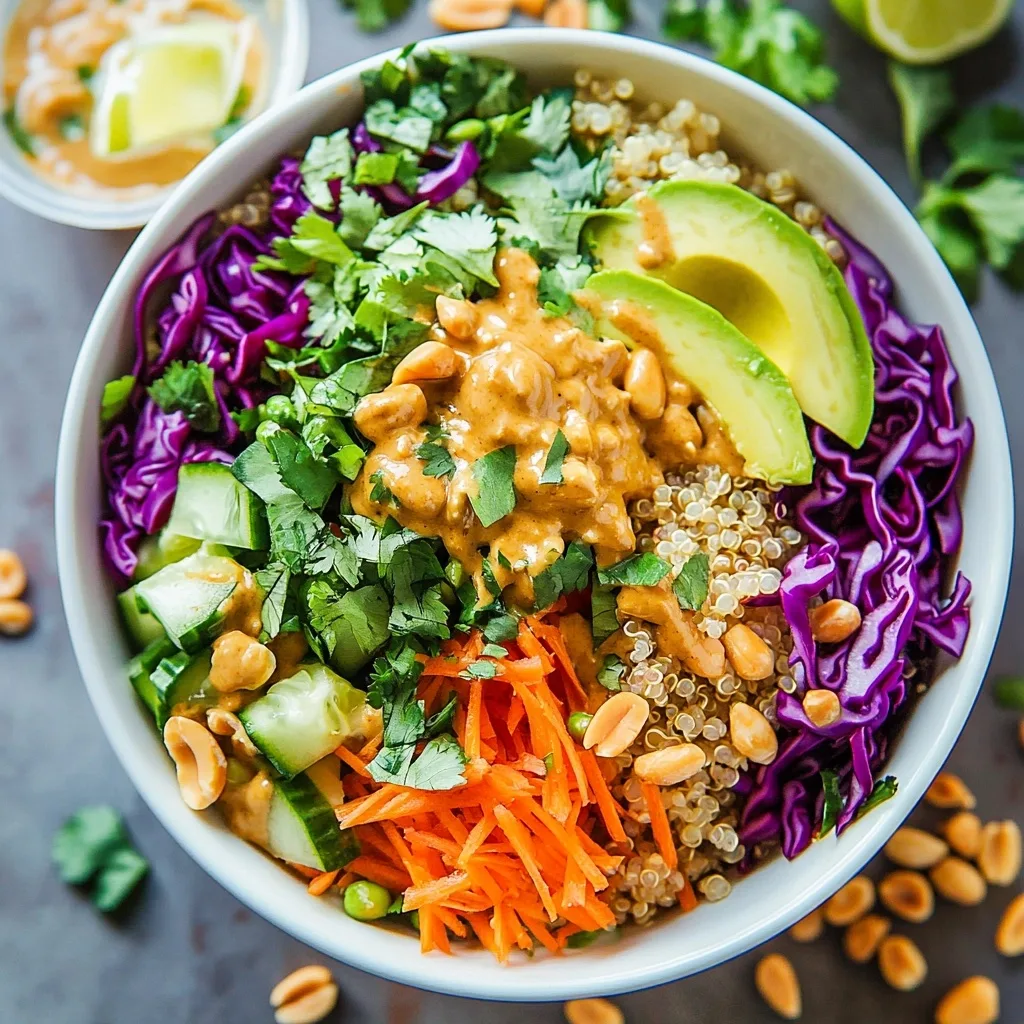
Mastering the Thai Peanut Buddha Bowl: Step-by-Step
Preparing the Base
The foundation of your Thai Peanut Buddha Bowl deserves attention. For perfectly cooked quinoa, rinse it thoroughly before cooking to remove the naturally occurring saponins that can impart bitterness. Use a 1:2 ratio of quinoa to water, bringing it to a boil before reducing to a simmer and cooking covered for about 15 minutes until the liquid is absorbed and the grains are tender with a slight bite.
Allow the quinoa to rest for 5 minutes after cooking, then fluff with a fork to separate the grains and release steam. This prevents the quinoa from becoming gummy or clumping together in your bowl. For enhanced flavor, consider cooking the quinoa in vegetable broth instead of water, or adding a bay leaf or sprig of thyme during cooking.
The quinoa should be warm but not hot when assembling your bowl—this allows it to maintain its distinct texture while still warming the vegetables slightly when placed beneath them.
Crafting the Perfect Thai Peanut Sauce
The sauce is the heart and soul of the Thai Peanut Buddha Bowl, so it deserves special attention. Begin with room-temperature peanut butter for easier mixing—natural peanut butter works best for its pure flavor and lack of additives, though any creamy variety will work in a pinch.
Combine all sauce ingredients except the water first, whisking until smooth. Then add warm water gradually, allowing you to control the consistency precisely. The ideal texture is somewhere between thick and pourable—it should coat the back of a spoon but still flow easily when drizzled. If you’re preparing the sauce in advance, you may need to add a touch more warm water just before serving, as it tends to thicken when refrigerated.
Don’t be afraid to taste and adjust as you go. The beauty of this sauce lies in its adaptability—more soy sauce for saltiness, additional maple syrup for sweetness, or extra ginger for zing. Make it your own by finding the perfect balance for your palate.
Vegetable Preparation Techniques
The way you prepare your vegetables significantly impacts both the presentation and eating experience of your Thai Peanut Buddha Bowl. Here are some techniques for optimal results:
- Red cabbage: Slice it thinly for easier eating and faster marination in the sauce. A mandoline can achieve uniform, paper-thin slices if available.
- Carrots: Use a julienne peeler for elegant strands, a box grater for a traditional shredded texture, or a vegetable peeler for delicate ribbons that add visual interest.
- Bell peppers: Cut into thin, consistent strips that distribute their sweet crunch throughout the bowl.
- Cucumber: Consider ribbon-cutting with a vegetable peeler for an elegant presentation, or simple dicing for ease of eating.
- Avocado: Slice just before serving to prevent browning, and consider fanning the slices for visual appeal.
- Edamame: Use pre-shelled varieties to save time, ensuring they’re thoroughly thawed if frozen.
For the freshest flavor and optimal texture, prepare your vegetables just before assembly. However, if you’re meal prepping, you can chop most components in advance and store them separately in airtight containers—just leave the avocado and sauce preparation until serving time.
Assembly Strategies for the Perfect Bowl
When creating your Thai Peanut Buddha Bowl, arrangement matters—both for aesthetics and eating experience. Start with the warm quinoa as your base, creating a canvas for the colorful components to follow. Rather than mixing everything together, place each vegetable in its own section around the bowl, creating a circular rainbow effect that’s visually stunning.
Leave a small space in the center for the avocado, creating a focal point that draws the eye. Drizzle the peanut sauce over the entire arrangement, allowing some to pool at the edges of the quinoa where it can be incorporated as you eat. Alternatively, serve the sauce on the side for dipping, which keeps the vegetables crisp longer—especially helpful for meal prep.
Finish with a generous sprinkle of chopped peanuts and fresh cilantro distributed across the top, and place lime wedges along the edge of the bowl for easy squeezing. This thoughtful arrangement not only creates an Instagram-worthy presentation but also allows you to experience different flavor combinations with each bite.
Thai Peanut Buddha Bowl Recipe
Ingredients
For the Bowl:
- 1 cup cooked quinoa (or brown rice if preferred)
- 1½ cups shredded red cabbage
- 1 cup shredded carrots
- 1 cup edamame, shelled and steamed
- 1 red bell pepper, thinly sliced
- 1 cucumber, diced or ribboned
- 1 avocado, sliced
- ½ cup chopped fresh cilantro
- ¼ cup chopped roasted peanuts
- Lime wedges for serving
For the Thai Peanut Sauce:
- ½ cup creamy peanut butter
- 2 tablespoons soy sauce
- 1 tablespoon maple syrup or honey
- 1 tablespoon rice vinegar
- 1 tablespoon toasted sesame oil
- 1 teaspoon fresh grated ginger
- 1 clove garlic, minced
- ¼ to ½ cup warm water (to adjust consistency)
- Optional: pinch of red pepper flakes or sriracha for heat
Instructions
- Prepare the quinoa: Cook according to package instructions and allow to cool slightly while preparing other ingredients.
- Make the Thai peanut sauce: In a medium bowl, whisk together peanut butter, soy sauce, maple syrup, rice vinegar, sesame oil, ginger, and garlic. Gradually add warm water until the sauce reaches your desired consistency. Taste and adjust seasonings as needed.
- Assemble the bowls: Divide the warm quinoa among four bowls. Arrange the red cabbage, carrots, edamame, bell pepper, cucumber, and avocado in sections around the bowl.
- Finish and serve: Drizzle generously with the peanut sauce. Sprinkle with fresh cilantro and chopped peanuts. Serve with lime wedges for squeezing over the top just before eating.
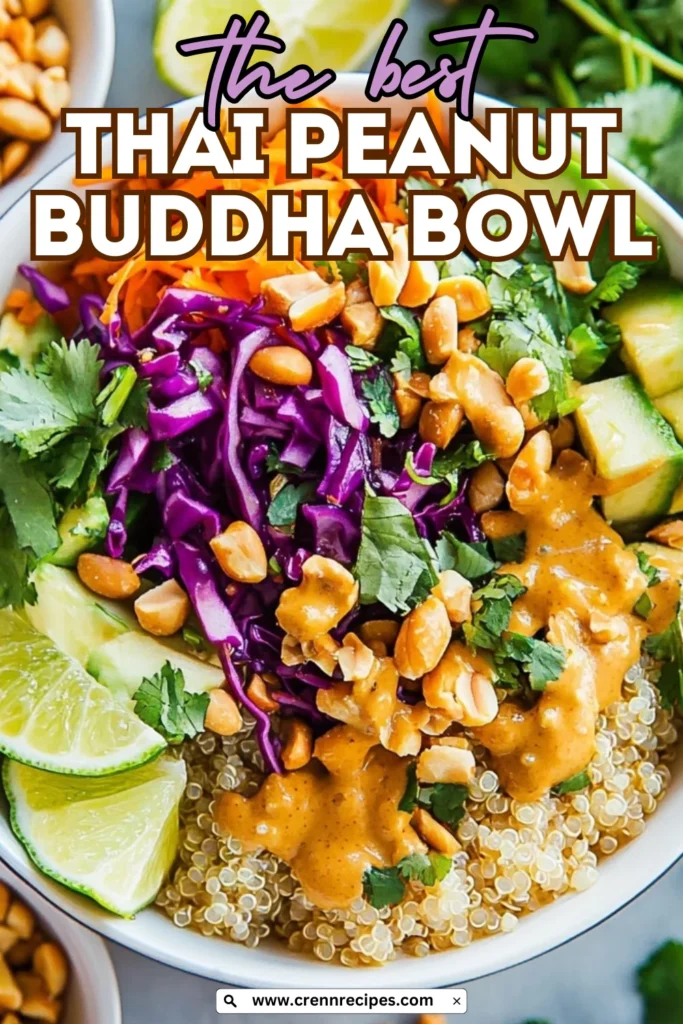
Customization and Variations
The Thai Peanut Buddha Bowl is wonderfully adaptable to different dietary needs and preferences. Here are some popular variations:
Protein Additions
While the edamame and peanut sauce already provide significant protein, you can boost the protein content further with these additions:
- Tofu: Cubed and baked or pan-fried with a light coating of soy sauce and sesame oil
- Tempeh: Marinated in a mixture of soy sauce, maple syrup, and garlic before cooking
- Grilled chicken: Sliced or shredded for non-vegetarian eaters
- Shrimp: Quickly sautéed with a touch of garlic and lime
Seasonal Adaptations
Adapt your Thai Peanut Buddha Bowl throughout the year by incorporating seasonal vegetables:
- Spring: Add snap peas, radishes, and asparagus tips
- Summer: Incorporate cherry tomatoes, corn kernels, and thinly sliced zucchini
- Fall: Include roasted sweet potato cubes, kale, and thinly sliced Brussels sprouts
- Winter: Add roasted butternut squash, massaged kale, and quick-pickled red onions
Dietary Modifications
Easily adjust this versatile bowl for different dietary requirements:
- Gluten-free: Substitute tamari for soy sauce in the peanut sauce
- Nut-free: Replace peanut butter with sunflower seed butter and substitute toasted sunflower seeds for the chopped peanuts
- Lower-carb: Use cauliflower rice instead of quinoa as the base
- Higher-protein: Double the edamame and add a protein source from the suggestions above
Make-Ahead and Storage Tips for Thai Peanut Buddha Bowls
The Thai Peanut Buddha Bowl is ideal for meal prep, with a few strategic considerations:
Component Preparation
For the freshest results throughout the week:
- Cook quinoa in bulk: It reheats beautifully and stays fresh for up to 5 days refrigerated.
- Chop hardy vegetables in advance: Cabbage, carrots, and bell peppers can be prepped 3-4 days ahead.
- Prepare the sauce separately: Store in a jar for up to a week, adding a splash of warm water to thin it before using if it’s thickened in the refrigerator.
- Leave delicate ingredients for last-minute: Cucumber, avocado, and cilantro are best prepared fresh.
Assembly Strategies
For meal prep containers, layer components strategically:
- Bottom layer: Quinoa base
- Middle layer: Hardy vegetables (cabbage, carrots, edamame, bell pepper)
- Top layer/separate container: Delicate items (cucumber, avocado, cilantro, peanuts)
- Separate container: Peanut sauce
This layering prevents sogginess and preserves the vibrant colors and textures that make the Thai Peanut Buddha Bowl so appealing.
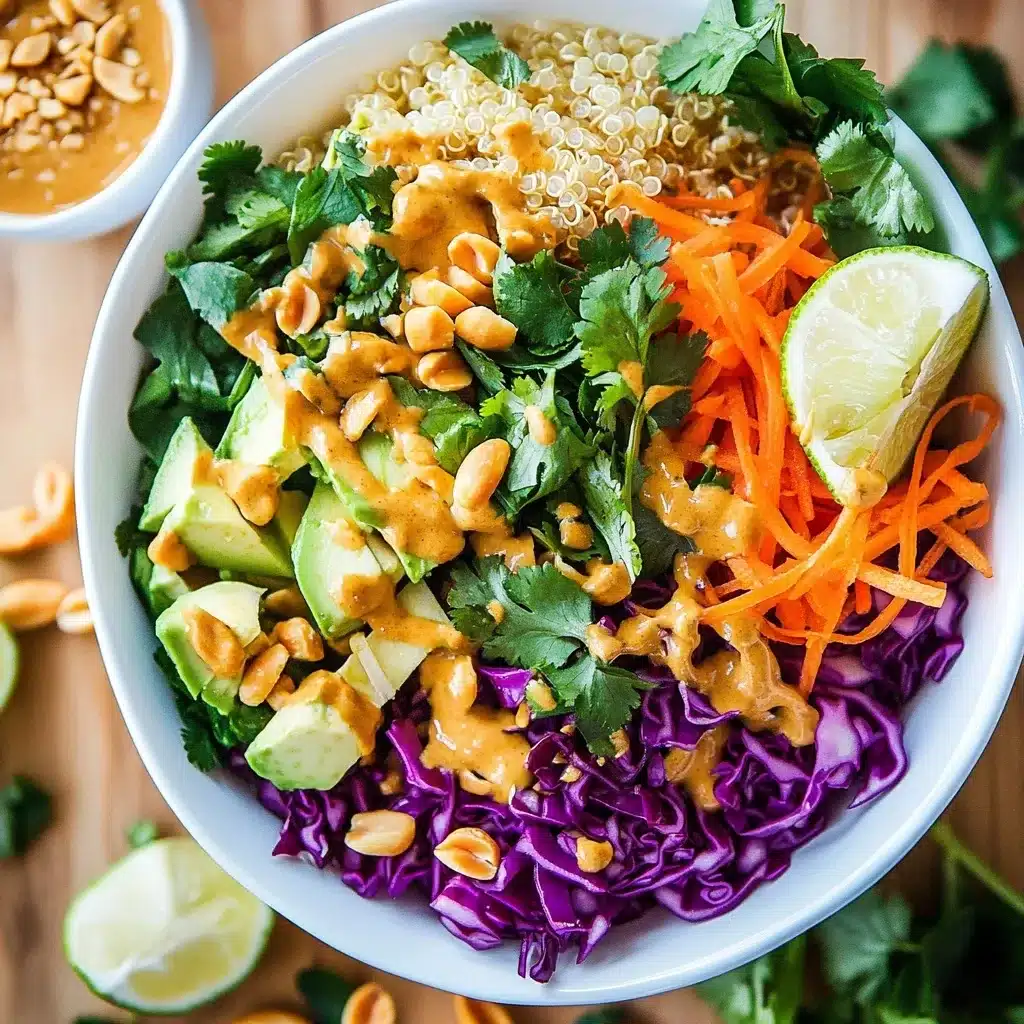
Health Benefits of Thai Peanut Buddha Bowls
Beyond being delicious, the Thai Peanut Buddha Bowl offers impressive nutritional benefits:
- Balanced macronutrients: The combination of complex carbohydrates from quinoa, healthy fats from avocado and peanut sauce, and plant proteins from edamame and peanuts creates a meal that provides sustained energy without blood sugar spikes.
- Rich in fiber: With approximately 15 grams of fiber per serving, this bowl supports digestive health, helps maintain healthy cholesterol levels, and promotes satiety.
- Abundant micronutrients: The rainbow of vegetables delivers a spectrum of vitamins, minerals, and phytonutrients that support immune function, skin health, and cellular repair.
- Anti-inflammatory properties: Ingredients like ginger, garlic, and colorful vegetables contain compounds that help reduce inflammation, potentially lowering the risk of chronic diseases.
- Heart-healthy: The monounsaturated fats in avocado and peanuts support cardiovascular health, while the fiber helps maintain healthy cholesterol levels.
Regular consumption of nutrient-dense meals like the Thai Peanut Buddha Bowl can contribute to overall health and wellbeing, proving that healthy eating can be both satisfying and delicious.
Frequently Asked Questions About Thai Peanut Buddha Bowls
Can I make Thai Peanut Buddha Bowls in advance?
Yes, these bowls are excellent for meal prep. Prepare all components separately and store them in airtight containers. Keep the sauce, avocado, and garnishes separate until serving time. Assembled bowls (without sauce and avocado) will keep for 3-4 days in the refrigerator.
How can I make the peanut sauce thicker/thinner?
For a thicker sauce, use less water or add more peanut butter. For a thinner consistency, gradually add additional warm water, coconut milk, or a touch of lime juice until you reach your desired texture.
Is this Thai Peanut Buddha Bowl vegan?
The bowl is vegetarian as written. To make it vegan, simply use maple syrup instead of honey in the peanut sauce. All other ingredients are plant-based.
Can I substitute the quinoa with something else?
Absolutely! Brown rice, jasmine rice, or cauliflower rice all work wonderfully as alternatives to quinoa. For a higher-protein option, consider using a mixture of quinoa and lentils.
What if I don’t like cilantro?
For those who experience the “soap taste” with cilantro, fresh basil or Thai basil makes an excellent substitute that complements the flavors beautifully. Alternatively, fresh mint can add a refreshing note that works well with the other ingredients.
Why Thai Peanut Buddha Bowls Deserve a Regular Spot in Your Meal Rotation
The Thai Peanut Buddha Bowl represents the perfect intersection of nutrition, flavor, and convenience. Its balance of complex carbohydrates, healthy fats, and plant proteins creates a satisfying meal that stabilizes energy levels and supports overall health. The vibrant colors not only create visual appeal but also indicate the diverse array of nutrients you’re consuming.
Beyond nutrition, these bowls offer remarkable versatility. They can be adapted to different seasons, dietary preferences, and available ingredients, making them a sustainable addition to your cooking repertoire. The make-ahead potential makes them ideal for busy lifestyles, while the impressive presentation makes them suitable for casual entertaining.
Perhaps most importantly, the Thai Peanut Buddha Bowl proves that healthy eating doesn’t require sacrifice. The bold flavors and varied textures create a dining experience that satisfies both nutritional needs and culinary desires—a rare combination that makes maintaining healthy habits significantly easier.
Incorporate this vibrant, nutritious bowl into your meal planning and discover how enjoyable balanced eating can be. Your body will appreciate the nutrients, and your taste buds will thank you for the flavor journey.
More Related Recipes You Might Enjoy
If you enjoyed this Thai Peanut Buddha Bowl, you might also love these other buddha bowl variations from our collection:
- Italian Buddha Bowl – A Mediterranean-inspired bowl featuring roasted vegetables, fresh herbs, and a balsamic drizzle that captures the essence of Italian cuisine in a nutritious format.
- Southwest Buddha Bowl – Featuring black beans, corn, avocado, and a zesty lime dressing, this bowl brings the vibrant flavors of southwestern cooking to your table in a balanced, nutritious package.
- Tofu Buddha Bowl – A protein-packed bowl centered around perfectly cooked tofu, complemented by a rainbow of vegetables and a tahini dressing that creates a harmonious flavor profile.
Each of these buddha bowl variations follows the same principles of balance, nutrition, and visual appeal while offering a completely different flavor experience. Mix and match them throughout your week for meals that are as diverse as they are delicious!
Print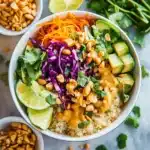
Thai Peanut Buddha Bowl: 10 Essential Secrets for Amazing Results
- Total Time: 35 minutes
- Yield: 4 servings 1x
- Diet: Vegetarian
Description
This vibrant Thai Peanut Buddha Bowl combines colorful vegetables, protein-rich edamame, and fluffy quinoa with a creamy, irresistible peanut sauce. Perfect for meal prep, this balanced bowl delivers a rainbow of nutrients in every bite. The contrasting textures and bold flavors create a satisfying meal that’s as beautiful as it is delicious!
Ingredients
- 1 cup cooked quinoa (or brown rice if preferred)
- 1½ cups shredded red cabbage
- 1 cup shredded carrots
- 1 cup edamame, shelled and steamed
- 1 red bell pepper, thinly sliced
- 1 cucumber, diced or ribboned
- 1 avocado, sliced
- ½ cup chopped fresh cilantro
- ¼ cup chopped roasted peanuts
- Lime wedges for serving
- ½ cup creamy peanut butter
- 2 tablespoons soy sauce
- 1 tablespoon maple syrup or honey
- 1 tablespoon rice vinegar
- 1 tablespoon toasted sesame oil
- 1 teaspoon fresh grated ginger
- 1 clove garlic, minced
- ¼ to ½ cup warm water (to adjust consistency)
- Optional: pinch of red pepper flakes or sriracha for heat
Instructions
- Cook quinoa according to package instructions and allow to cool slightly while preparing other ingredients.
- In a medium bowl, whisk together peanut butter, soy sauce, maple syrup, rice vinegar, sesame oil, ginger, and garlic.
- Gradually add warm water until the sauce reaches your desired consistency. Taste and adjust seasonings as needed.
- Divide the warm quinoa among four bowls. Arrange the red cabbage, carrots, edamame, bell pepper, cucumber, and avocado in sections around the bowl.
- Drizzle generously with the peanut sauce. Sprinkle with fresh cilantro and chopped peanuts.
- Serve with lime wedges for squeezing over the top just before eating.
Notes
- For meal prep: Store all components separately and assemble just before eating.
- Make it vegan: Use maple syrup instead of honey in the peanut sauce.
- If you don’t have edamame, substitute chickpeas or tofu for protein.
- The sauce can be made up to a week ahead and stored in an airtight container in the refrigerator.
- For a spicier version, add additional sriracha or red pepper flakes to the peanut sauce.
- Prep Time: 20 minutes
- Cook Time: 15 minutes
- Category: Main Dish
- Method: Assembly
- Cuisine: Thai-Inspired
Nutrition
- Serving Size: 1 bowl
- Calories: 420
- Sugar: 8g
- Sodium: 580mg
- Fat: 24g
- Saturated Fat: 4g
- Unsaturated Fat: 18g
- Trans Fat: 0g
- Carbohydrates: 42g
- Fiber: 10g
- Protein: 15g
- Cholesterol: 0mg

